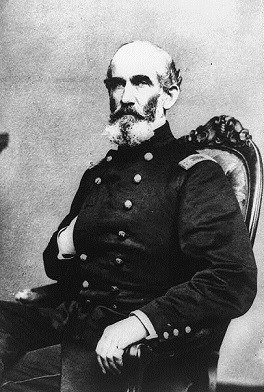
Lt. Colonel George Armstrong Custer’s court martial continued after a hiatus of a few days, on October 5 th , 1867. Major Joel Elliott, Custer’s second in command, testified as a witness on the part of the prosecution. Several questions asked to Elliott dealt with the offenses Custer was accused of. The first set of questions asked to Elliott related to Custer’s treatment of deserters the previous July (note Custer is referred to by his prior Civil War rank of general):
“Q. Were you with your regiment or a portion thereof on the march from the Platte River to Ft. Wallace in July last?
Q. On that march were there any deserters?
Q. Do you know of any orders having been given in regard to any deserters on that march?
Q. State what orders were given to you, if any, and by whom.
A. There were some men deserted from the 7 th Cav. At the place where we had halted, and there were orders given by the commanding officer, Gen. Custer, to go out and bring them in, or arrest them or stop them - I don’t recollect the first order. Just as I started the General said to me, ‘I want you to shoot them’, or words to that effect. I was not ordered to go out. I asked Gen. Custer to allow me to go out after those deserters, and I think it was just as I was in the act of mounting horse that I received the order to shoot them.
Q. Did you go after them?
Q. Had the other deserters surrendered at the time they were fired at?
A. They had; they surrendered at the first order.
Q. Had they thrown their arms down?
A. They halted at the first order to halt, and two threw their arms down at the first order to throw them down.
Q. Who was the man not armed?
A. He was a Bugler of 'K' Co. – I don’t recollect his name.
Q. Had he any arms at all when you first saw him?
A. I saw none with him.”
The next set of questions dealt with the condition of the horses of the 7 th Cavalry before Custer’s expedition from Fort Wallace to Fort Harker. This was a point of contention for the prosecution - because Custer supposedly had left fort Wallace not only without leave, but also with army horses in no condition to undertake a new journey:
“Q. What was the condition of the horses, as far as you know, when the command arrived at Fort Wallace?
A. They were very much exhausted and worn.
Q. Were they fit for service?
A. Not for hard service.
Q. Were they in condition for a march of a hundred or two miles?
A. No sir; they were not.
Q. Had the horses of the command been rested sufficiently to take a march of a hundred or two miles a day or two after that?
A. I think a day or two was not sufficient to put them in condition.
Q. How long did the whole command remain at Fort Wallace?
A. A portion of the command left on the afternoon of the 15 th .
Q. For what purpose?
A. They left as an escort for Gen. Custer I believe, who was going east on the road."

October 11th, 1867
On October 11 th , 1867, Lt. Colonel George Armstrong Custer was no doubt contemplating the verdict of his court martial. For nearly a month Custer was on trial for a variety of offenses - most notably being absent without leave and the shooting of deserters. On October 11 th , the court went into deliberation and finally came up with a verdict.
However, before the verdict, Custer was allowed to provide a written defense. Custer prepared an ornate, lengthy defense about being absent from his command. One of the first paragraphs read as follows:
“Of the first stage of that journey, viz.: from Fort Wallace to Fort Harker, I have to say that I accomplished it on account of what I believed to be, and had just cause to believe to be, urgent public business. And of the second I have to say that I went to Fort Riley with the full knowledge and consent of Bvt. Maj. Gen. Smith, my immediate commanding officer. In support of the first proposition the following account of the operation of my command is submitted. The Court will see that it is certified by the evidence on the record.”
Custer further elaborated on the nature of his orders when he arrived at Fort Wallace in July of 1867:
“Now, Gentlemen, it is proper to come to judgement. My orders were before me. I was directed to report to Gen. Hancock. Fort Wallace was the point named where it was expected, it seems, to meet him, under the supposition that I would receive my orders a week earlier than I did. But even, as if to provide for an unforeseen failure, Fort Wallace was not named as the point where I should report to him. On the contrary I was ordered to proceed with all my command in search of Indians towards Fort Wallace and report to General Hancock. Weather he were at Wallace or Denver or Harker, at one of which, or between two of which, he was then.”
The Judge Advocate, Captain Robert Chandler, then proceeded to reply to Custer’s written defense. Chandler emphasized the evidence and eyewitness testimony that had been heard throughout the trial, generally brushing off any argument Custer made in his defense. With Chandler’s reply finished, the court was then cleared for deliberations.
Custer was found guilty of five of the charges and specifications found against him. The result of the verdict by the court was as follows:
“In consequence the Court sentenced Brevet Major General G.A. Custer, Lieutenant Colonel, 7 th U.S. Cavalry, to be suspended from rank and command for one year, and forfeit his pay for the same time.”
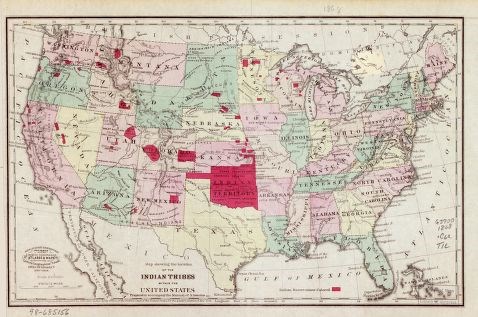
October 13th, 1867
With Custer’s trial winding down in October of 1867, a more important event that would affect relations between whites and Native Americans was about to take place. The goal of the event was to solve a monumental question, one that still resonates with us today. How to create a lasting peace with Native Americans? A seemingly contradictory goal - when Manifest Destiny was the paramount objective for the United States at the time. The Cincinnati Gazette at the time was blunt on the matter “The facts are obvious and men are either idiots or knaves who do not see that nothing short of the strong arm of the government will subdue these demons of the plains.”
During the summer of 1867, Senator John Henderson perhaps spoke for much of the country on what to do about the conflict on the Great Plains. The senator presented a bill in Congress “To treat with certain hostile Indians…now warring with the United States or committing depredations.” The senator’s goal was to create a peace commission to create an agreement to “remove the causes of war; secure the frontier settlements and railroad construction; and establish a system for civilizing the tribes.” The peace commission outlined eventual goals – the settlement of the land, and the “civilizing” of Native Americans.
A large contingent of peace commissioners was formed, composing of officials such as the Commissioner of Indian Affairs N.G. Taylor, a large number of senior army officers, and Senator John Henderson himself. They were accompanied by a retinue of members of the press and an escort of soldiers. On the 13 th of October, 1867, the long column of 165 wagons made its way (with trepidation) to meet with Indians of the Great Plains for peace. The meeting for this great council would occur near Medicine Lodge Creek in south-central Kansas.
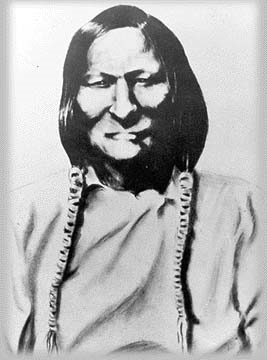
October 19th, 1867
Black Kettle was in a precarious position. One of many Cheyenne chiefs, Black Kettle was a firm believer that peace with the whites would be the only answer to peace on the Great Plains. He was also risking his own personal safety and that of his family in taking this stance.
With many of the Great Plains Indian Tribes being notified of an important council to occur at Medicine Lodge Creek in Kansas, Black Kettle was determined to create a lasting peace for his people. In September and October of 1867, Black Kettle was ridiculed by many Cheyenne for believing in peace. In some cases he and his family were even threatened with harm; usually such threats coming from the militant Cheyenne Dog Soldiers.
Despite this, Black Kettle was one of the first chiefs present to warmly welcome the officials and dignitaries who were there to begin peace talks. The peace commissioners were composed of military officers, Indian agents, reporters, and an escort of 500 soldiers of the 7 th Cavalry. The Medicine Lodge Council, as it would be known, would begin in south central Kansas.
The great council was a meeting place for many Native Americans – possibly as many as 5,000 people were present. Along with Black Kettle and the Cheyenne, there were Arapaho, Comanche, Kiowa, and Apache tribes. The atmosphere was tense for both sides, as a grand council began on October 19 th with Black Kettle and White Head being the only Cheyenne chiefs present. However, with so few Cheyenne present for the talks, Black Kettle remained largely silent. His ultimate hope was to bring more Cheyenne chiefs to his side. He would spend the next few days attempting to do just that.
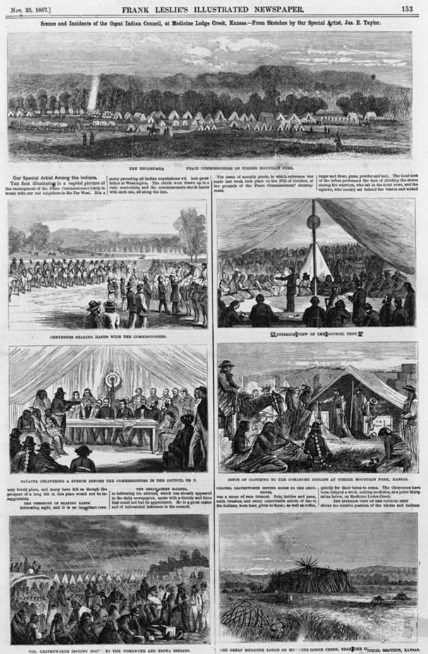
October 27th, 1868
On the morning of October 27 th , 1868, with the Medicine Lodge Treaty continuing for several days, an unexpected sight greeted the contingent of peace commissioners and newspaperman present. It was Black Kettle, who had disappeared for a few days; he now arrived at the head of a large number of Cheyenne warriors and chiefs. A newspaper correspondent at the time described the scene:
“Five columns of a hundred men each, forty paces apart, dressed in all their gorgeous finery. Crimson blankets about their loins, tall comb-like headdresses of eagle feathers, variegated shirts, brass chains, sleigh bells, white, red and blue bead-worked moccasins, gleaming tomahawks, made up the personnel of a scene never to be forgotten.”
“Their chief, Mo-ko-va-ot-o, or Black Kettle, mounted upon a wiry horse, sprang forward, dressed in a dingy shirt and dingier blanket, his long black hair flowing behind him like a bashaw’s tail, and waved his hands. In most admirable order they moved by the left flank by divisions; another wave and they marched obliquely across the Neo-contogwa-up to within 50 yards of Commission Camp, where they halted, but still continued their lively exhilarating chant until the commission appeared in full dress and halted within a few paces of the line.”
Black Kettle was finally able to bring other Cheyennes to the peace table.
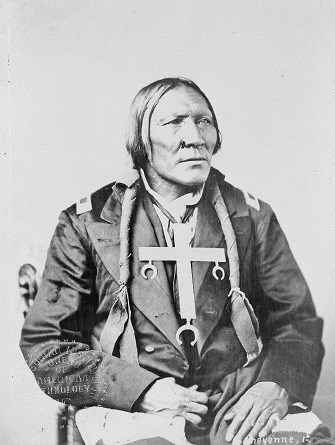
October 28th, 1867
The previous day, October 27 th , 1867, Black Kettle arrived with a large number of Cheyennes to engage in peace treaty talks. The next morning, Cheyenne and Arapaho Chiefs gathered to hear Senator John Henderson begin. The senator emphasized that that they would have to give up their land between the Arkansas and South Platte Rivers (parts of Kansas and Nebraska). However, to the chiefs present, this was unacceptable. Buffalo chief was quoted as saying “We never claimed any land south of the Arkansas, but that country between the Arkansas and the South Platte is ours.”
By all accounts, the senator was eager to get the treaty signed that day. Seeing the chiefs’ determination to keep the land, Senator Henderson took some of them aside with an interpreter. He told them they could hunt north of the Arkansas River, but would still have to reside permanently south of it. Although the promise was made, it was not stated in the treaty document that the chiefs would sign. When it was brought up by correspondent William Fayel that the wording of the treaty be changed to reflect Henderson’s promise, Henderson responded “It’s no time for bickering”.
Pleased with the compromise, many of the Cheyenne chiefs joined in the signing of the treaty - including Black Kettle. Not all chiefs were eager to sign the treaty. Little Robe, who had expressed anger two days before, declared the treaty had enough signatures. It took some cajoling to get the other Cheyenne chiefs to sign as well. Afterwards, presents were given to them by the peace commissioners; these included cast iron weapons of inferior quality. One pistol was tested by a Cheyenne and it exploded in his hands! Nonetheless, the Cheyennes and Arapahoes had agreed to and signed the treaty. Other treaties at Medicine Lodge were also completed with the Comanche, Kiowa, and Apaches. October 28 th , 1867, however, would mark the last time the United States negotiated a treaty with the Southern Plains tribes.
Frost, Lawrence A. The Court-Martial of General George Armstrong Custer.
Norman: University of Oklahoma Press, 1968. (p 178-79, 182-83, 216-46)
Hatch, Tom. Black Kettle: The Cheyenne Chief Who Sought Peace But Found War.
Hoboken: John Wiley and Sons inc., 2004. (p 221, 229-30, 230-32)
Jones, Douglas C. The Treaty of Medicine Lodge, The Story Of The Great Treaty Council As Told By Eyewitnesses.
Norman: University of Oklahoma Press, 1966. (p 15-18, 70-71, 137-141, 176-78)